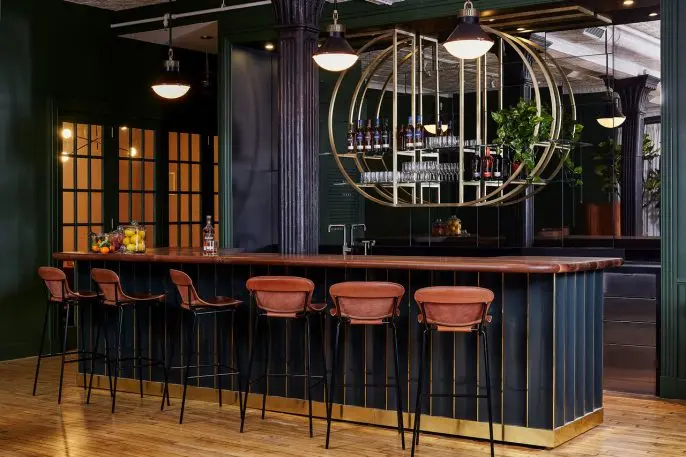There’s no shortage of sobering stats on the gender parity gap: Only 2% of venture capital funding went toward female founders last year, and the percentage of women CEOs at Fortune 500 companies actually declined. This stark reality stands despite a new era of female entrepreneurship and community building, as evidenced by the success of coworking spaces such as The Wing and female-centered business conferences like Create + Cultivate.
But what about women at the very, very top? What about the C-suite executives?

Women hold just 5% of the CEO jobs in the S&P 500, and those attempting to smash the glass ceiling often find the path strewn with obstacles, like gender-based biases and preconceived notions as to what constitutes a leader. Female CEOs are twice as likely as men to come from outside a company than be chosen internally, finds a Harvard Business Review report.
At the current rate, society will need two more centuries to achieve gender parity in the workplace. That’s why groups like Chief are needed to prime the feminist ecosystem, says cofounder Lindsay Kaplan.
“We haven’t seen change happen quickly,” Kaplan tells Fast Company. “We are really motivated to actually provide the services that can help make a giant dent.”
A personal need
Kaplan and cofounder Carolyn Childers know the struggles intimately. Childers previously served as SVP of operations at Handy, where she helped grow the company and secure $100 million in funding, and Kaplan was VP of communications and brand at mattress giant Casper, a Fast Company most innovative company.
The two regularly met for coffee to discuss their professional development and challenges. It was during one caffeinated meetup they realized that the more senior they had become, the fewer outlets they had for the kind of guidance they gave one other.
Related: Millennial women’s business conferences: safe space or pink silo?
“It came from a very personal place,” recounts Childers, now Chief’s CEO. “The higher we grew in our personal careers and our lives, the more time we were spending helping other people–and we weren’t spending time helping ourselves.”

While many female-focused organizations center on community, Chief places the emphasis on mentorship and coaching. The network sorts incoming members into groups of 8 to 10 individuals who are aligned with their level of responsibility and experience, though not necessarily the same industry.
Childers refers to the core service as “executive coaching on steroids,” in which members can tap into a rich resource of peers to work through professional issues. In fact, applicants noted that a network of power players was their number-one request.
“These women who are at the top are generally alone on an island,” says Kaplan, Chief’s experience officer. “And mentorship doesn’t mean you need to find somebody a decade older than you to talk about your career with.”
The Tribeca clubhouse will offer a salon series with topics such as “how to get on a board,” while workshops might center on media training. These Chief quarters are not meant as a coworking space; the cofounders note that members already have their own offices and “are very busy.”
As for the design and decor, don’t expect an onslaught of millennial pink or infantilizing “girl”-centric branding. Chief harbors a more subdued, classic feel; hunter green-hued walls, tan leather armchairs, with cream-hued accents and potted plants throughout. The clubhouse will serve scotch and host a monthly poker night. It’s grown-up, a space meant to appeal and resonate with more senior women than those at the start of their careers.

“It’s often in the green room which is where [a woman] gets to meet with all of her other contemporaries and continue to build her network,” explains Childers. Chief, therefore, aims to be “an ongoing green room for her to be able to get the resources where she can invest in herself.”
External resources
Of course, none of this comes cheap. Membership starts at $5,400 for a VP level and $7,800 for C-suite executives. Chief already boasts a 3,000-person wait list, many of whom are sponsored by their own companies. Human resource departments are eager to cover the cost, which is more or less on par with the price of just one leadership conference.
“Once you take women outside of their own company and their own direct colleagues, there is a level of conversation that is just so much more productive because it’s less about what’s happening day-to-day in the business and more about carving a path toward their own success,” explains Childers.
Confidentiality and trust is another issue, which, Kaplan notes, is “just impossible to achieve within the four walls of one’s own business.”
Since position titles vary across the country and industries, Chief screens as to whether they are indeed influential or potential changemakers in the making. The team weighs each applicant in terms of what they’re trying to get out of the network, as well as what they offer the broader community.
Related: The first feminist comedy club is ready to bring the funny
Apart from professional accomplishments, Chief also gauges other issues in onboarding members: How close is one to burning out? How isolated does she feel? What is it that you want most–compensation, recognition, mentorship? What do you need for success?

Upon Chief’s announcement in October, the duo tapped their own professional networks, and interest spread organically by word of mouth. The founders say they were surprised by the large number and caliber of the applicants. They had initially assumed it would err on less senior personnel, but a strong majority consist of women at the executive level. The founding group is 200-members strong and includes execs from Walmart, HBO, Spotify, WeWork, PepsiCo, AmEx, Away, and Hearst.
“You always assumed that people who are more senior than you have figured it out and don’t need resources like that,” says Childers. “But we realized that even with the most senior women, this is something that struck a chord.”
Applicants come from a wide range of industries with heavy representation in tech, commerce, enterprise, retail, media, entertainment, and CPG. All are female, although Chief isn’t necessarily opposed to male input if it helps them achieve their greater goals.

Essentially, Chief isn’t ruling out any idea or strategy when it comes to establishing women at the very top.
“We joke that until we can create a time machine in the back of Chief, we’re going to have to work harder because we reject waiting 200 years to get to gender parity,” says Kaplan. “It’s just simply a number that we refuse to believe cannot be improved upon.”
Recognize your brand’s excellence by applying to this year’s Brands That Matter Awards before the early-rate deadline, May 3.
